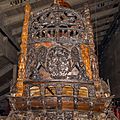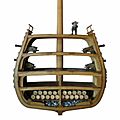Vasa (ship) facts for kids
The Vasa was a huge Swedish warship built a long time ago, between 1626 and 1628. It was meant to be a powerful symbol for Sweden. But on its very first trip, called its maiden voyage, the Vasa sank right outside Stockholm! This happened because the ship was too heavy at the top. The people who built it knew there were problems, but they were scared to tell the king, Gustavus Adolphus. He was away and wanted the ship ready quickly to join a big war called the Thirty Years' War. After the sinking, people looked into why it happened, but no one was ever blamed.
Many years later, in the 1660s, Swedish divers used special diving bells to bring up some of the Vasa's cannons from the sunken ship. Then, in 1956, a man named Anders Franzén found the Vasa again! He had read old stories about the ship and searched for it in the waters around Stockholm. The ship was finally brought up from the sea in 1961. It then needed a lot of special care, using chemicals to make sure the wood would last for a very long time. This special treatment took almost 20 years! Today, the Vasa is safe in the Vasa Museum in Stockholm, Sweden. It's a super popular place, with over a million visitors every year!
When the Vasa was brought up, thousands of amazing things were found inside. There were human bones, clothes, weapons, tools, old coins, food, and even some of the original sails! All these items, along with the ship itself, have been incredibly helpful for historians. They give us a clear picture of what life was like in Sweden in the 1600s. The Vasa was a very expensive ship and one of the biggest in the world at the time. It had hundreds of beautiful sculptures, painted in many bright colors. It was built to show how strong Sweden was and how great its king wanted to appear.
Contents
Why Did the Vasa Sink?
The Vasa was designed to be a mighty warship, but it had a big flaw. It was built with too much weight high up on its hull. This made the ship very unstable. Imagine trying to stand on one leg while carrying a heavy backpack on your head – you'd be wobbly! That's what happened to the Vasa.
The King's Orders
King Gustavus Adolphus was in charge when the Vasa was being built. He was a powerful king who wanted Sweden to be a strong country. He was also busy fighting in the Thirty Years' War in Europe. The king wanted the Vasa to join the war quickly. He kept pushing the builders to finish the ship fast.
The Builders' Dilemma
The shipbuilders knew there were problems with the Vasa's design. They knew it might not be stable enough. But they were afraid to tell the king. They worried he would be angry if they said his new warship wasn't safe or couldn't be finished on time. So, they kept quiet, and the ship was launched as planned.
The Maiden Voyage Disaster
On August 10, 1628, the Vasa set sail for its very first journey. It only traveled about 1,300 meters (about 4,200 feet) before disaster struck. A strong gust of wind hit the ship. Because it was so top-heavy, the Vasa tipped over. Water rushed into the open lower gun decks, and the ship quickly sank to the bottom of the harbor.
Finding and Saving the Vasa
For over 300 years, the Vasa lay at the bottom of the sea. It was mostly forgotten until Anders Franzén became interested in finding old shipwrecks.
The Search and Discovery
Anders Franzén was a marine archaeologist, someone who studies old things found in the sea. He spent many years searching for the Vasa. He read old documents and used a special tool to find objects underwater. In 1956, he finally found the Vasa! It was in surprisingly good condition because the cold, brackish (slightly salty) water of the Baltic Sea helped preserve the wood.
Raising the Ship
Bringing the huge Vasa to the surface was a massive project. It took five years of careful planning and hard work. Divers dug tunnels under the ship and passed strong cables through them. These cables were then attached to large floating pontoons. Slowly, step by step, the Vasa was lifted from the seabed in 1961. It was an amazing moment for Sweden and for history!
Preserving a Piece of History
Once the Vasa was out of the water, the real challenge began: keeping it from falling apart. Wood that has been underwater for centuries needs special care. The ship was sprayed with a chemical called polyethylene glycol (PEG) for many years. This chemical slowly replaced the water in the wood, making it strong and stable. This long process helped save the Vasa so we can still see it today.
Life on Board the Vasa
When the Vasa was found, it was like a time capsule from the 1600s. Thousands of items were preserved inside the ship.
Everyday Objects
Historians found many things that tell us about daily life for the sailors. There were clothes, shoes, tools for repairs, and even cooking pots. They also found barrels of food and drink. These items show us what people ate and how they lived on a warship in the 17th century.
Weapons and Tools
As a warship, the Vasa carried many weapons. Besides the cannons, there were muskets, swords, and pistols. Tools for maintaining the ship were also found, like hammers, saws, and ropes. These discoveries help us understand how the ship operated and how the crew worked.
Personal Belongings
Among the findings were personal items belonging to the crew. There were coins, dice for games, and even musical instruments. These small details give us a glimpse into the lives of the individual sailors and what they brought with them on their voyages.
Images for kids
-
A Backgammon set found on Vasa, complete with dice and markers
-
Vasa's port side
-
Illustration from a treatise on salvaging from 1734, showing the traditional method of raising a wreck with the help of anchors and ships or hulks as pontoons, basically the same method that was used to raise Vasa in the 20th century.
-
Former Vasa Museum Director Klas Helmerson (left) explaining aspects of the sinking of the ship to then US Defense Secretary William Cohen (centre) and Swedish Defense Minister Björn von Sydow (right).
See also
 In Spanish: Vasa para niños
In Spanish: Vasa para niños




















